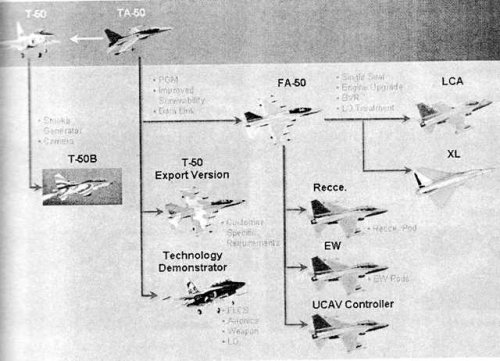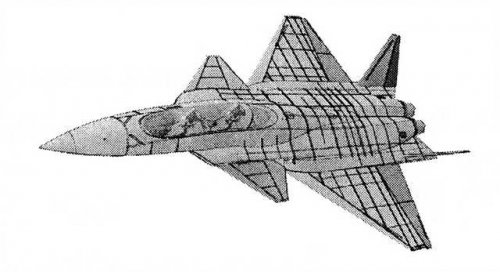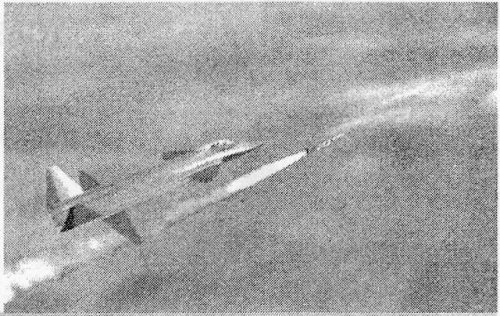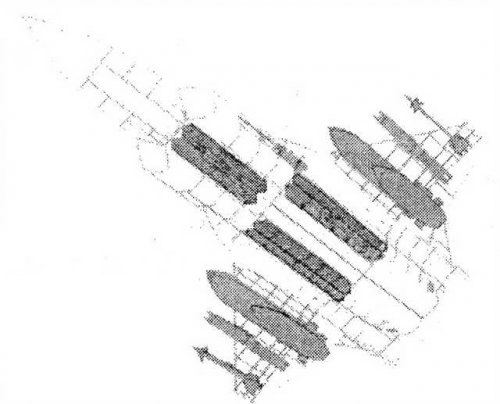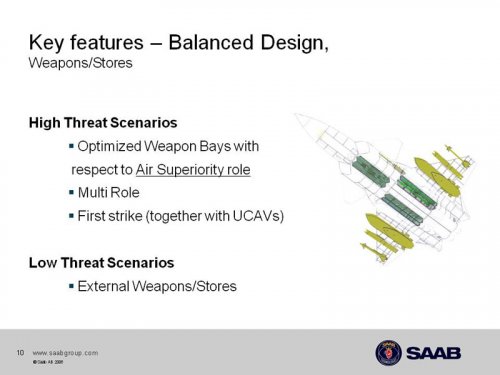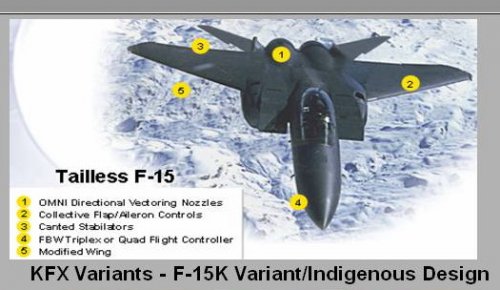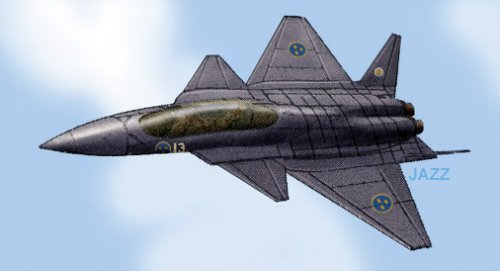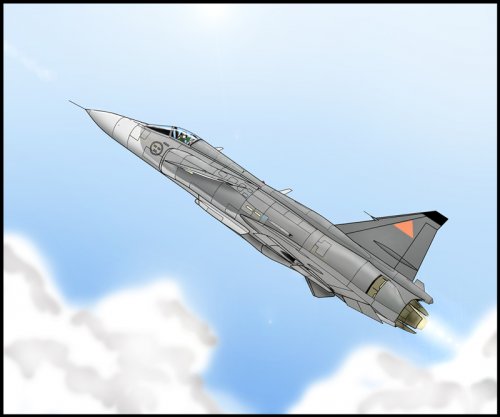You are using an out of date browser. It may not display this or other websites correctly.
You should upgrade or use an alternative browser.
You should upgrade or use an alternative browser.
Advanced F-15 and SAAB concept for South Korea
- Thread starter hesham
- Start date
- Joined
- 4 May 2008
- Messages
- 2,439
- Reaction score
- 762
This week's AvWeek has an article on South Korea future aircraft procurement plans. SAAB is offering a stealthy-ish canard, reminescent of some old ATF artist's concepts. The interesting - well, curious at least - bit, is Boeing's revival of a 1990's F-15 mod concept (I had never heard of it).
The article has what looks like a poorly photoshopped picture of a -15, with the vertical fins deleted, and the horizontal tails canted up thirty degrees a la YF-23. It also says the nozzles are thrust vectoring (although in the picture they look like the standard axisymmetric kind).
Additional text boxes say "New flap for collective flap/aileron control", "strengthened wing for high-speed flap", and "FBW flight control system".
The article goes on to say: "the advantage of such an aircraft would be lower radar reflections, weight, and drag".
Funny thing is that the inlets, which are wonderful corner reflectors, with direct sight to the compressor blades, look stock. It reminds me of that saying, about trying to hide an elephant in a strawberry field by painting its toenails red...
The article has what looks like a poorly photoshopped picture of a -15, with the vertical fins deleted, and the horizontal tails canted up thirty degrees a la YF-23. It also says the nozzles are thrust vectoring (although in the picture they look like the standard axisymmetric kind).
Additional text boxes say "New flap for collective flap/aileron control", "strengthened wing for high-speed flap", and "FBW flight control system".
The article goes on to say: "the advantage of such an aircraft would be lower radar reflections, weight, and drag".
Funny thing is that the inlets, which are wonderful corner reflectors, with direct sight to the compressor blades, look stock. It reminds me of that saying, about trying to hide an elephant in a strawberry field by painting its toenails red...
- Joined
- 3 June 2006
- Messages
- 3,094
- Reaction score
- 3,964
signatory @ Key Publishing Ltd Aviation Forums said:...
This is from Saab, thanks to murphy for finding them:
Attachments
- Joined
- 3 June 2006
- Messages
- 3,094
- Reaction score
- 3,964
- Joined
- 3 June 2011
- Messages
- 18,338
- Reaction score
- 12,241
AeroFranz said:It also says the nozzles are thrust vectoring (although in the picture they look like the standard axisymmetric kind).
Unless they happen to be positioned off-axis most 3D nozzles look like standard nozzles. See F-16 VISTA, F-15 ACTIVE, Su-30 MKI, Mig-35 etc.
AeroFranz said:The article goes on to say: "the advantage of such an aircraft would be lower radar reflections, weight, and drag".
Funny thing is that the inlets, which are wonderful corner reflectors, with direct sight to the compressor blades, look stock. It reminds me of that saying, about trying to hide an elephant in a strawberry field by painting its toenails red...
They're probably talking about giving it the Super Hornet kind of RCS reduction treatment. In which case they are correct, it would reduce the RCS. (But it certainly wouldn't be a stealth aircraft by any stretch.)
- Joined
- 27 May 2007
- Messages
- 676
- Reaction score
- 46
How much do you have working room with a manned stealth fighter anyway?
-snaky air tube so the intakes are on the side / below and the engines on the back,
-trapezoidal wing, angled vertical stabilizers to prevent sharp corners ("armpits"),
-then the only real configuration choice left is no horizontal stabilizers, conventional ones, or canards?
-snaky air tube so the intakes are on the side / below and the engines on the back,
-trapezoidal wing, angled vertical stabilizers to prevent sharp corners ("armpits"),
-then the only real configuration choice left is no horizontal stabilizers, conventional ones, or canards?
AeroFranz said:This week's AvWeek has an article on South Korea future aircraft procurement plans. SAAB is offering a stealthy-ish canard, reminescent of some old ATF artist's concepts. The interesting - well, curious at least - bit, is Boeing's revival of a 1990's F-15 mod concept (I had never heard of it).
The article has what looks like a poorly photoshopped picture of a -15, with the vertical fins deleted, and the horizontal tails canted up thirty degrees a la YF-23. It also says the nozzles are thrust vectoring (although in the picture they look like the standard axisymmetric kind).
Additional text boxes say "New flap for collective flap/aileron control", "strengthened wing for high-speed flap", and "FBW flight control system".
The article goes on to say: "the advantage of such an aircraft would be lower radar reflections, weight, and drag".
Funny thing is that the inlets, which are wonderful corner reflectors, with direct sight to the compressor blades, look stock. It reminds me of that saying, about trying to hide an elephant in a strawberry field by painting its toenails red...
For those fighters with direct sight to their compressor blades - F-15, F/A-18, X-32, etc - radar blockers can take care of that problem.
Aviation Week & Space Technology 03/19/2001
Stealth Engine Advances
Revealed in JSF Designs
DAVID A. FULGHUM/ORLANDO, FLA. and WASHINGTON
[snip]
"Radar blockers" or "stealth intake devices"have been developed for Boeing's F/A-18E/F and F-22 and are even being improved on the former aircraft. The difference is that the blocker is a separate device on Super Hornet, while it is an integral part of the engine, at least in the Boeing version of the JSF. The F-22 and Super Hornet use a combination of curved inlets and radar blocker technologies.
The first-generation SR-71 used huge inlet spikes to control radar reflections. The second-generation F-117 uses a more primitive grid device over the inlet as a radar blocker. A finer mesh screen was used on Northrop's Have Blue proposal, which would have choked air flow and limited top speed to about Mach 0.65. (AW&ST Feb. 10, 1992, p. 23). These earlier designs were abandoned in response to the demand for supersonic strike aircraft and cheaper, more robust stealth. Keeping radar beams out of the engine is a particular concern for aircraft with a single, large engine inlet.
The F-117's inlet screens, when aligned with the rest of the aircraft's external faceting, help create uniformly conducting electrical surfaces that allow radar waves to flow around the stealth aircraft and exit from its aft-most point. Some stealth specialists worry that these signals, emitted to the rear of the aircraft, could provide the basis for a counter-stealth defense system.
The Boeing JSF's intake radar blocker is built as part of the face of the engine with a bullet-like centerpiece surrounded by angled, radiating vanes. In parallel, the U.S. has developed infrared and radar suppression devices for jet exhausts and these have been flying on stealth aircraft for a number of years. These two types of blockers are generally used in conjunction with one another and the latter has become increasingly sophisticated as researchers find better ways to deal with an environment of extreme exhaust heat.
"We've been using blockers in aircraft exhausts for many years," said a senior aerospace official. "It doesn't significantly affect the engine's airflow [which translates to power] through the exhaust, but [when used in an inlet, a blocker] has the potential to restrict airflow into the engine."
Some stealth specialists say the loss in engine efficiency when using a blocker would be limited to only a few percent, and may be offset by the greater efficiency of a single large engine inlet (Boeing's option) compared to two smaller inlets (Lockheed Martin's design). Others say the effects of a blocker inside an inlet are more pernicious.
"It's physically easier and more robust to build a long, serpentine duct and hide the [engine face], compared to the difficulties of putting in a [blocker] device," said a second stealth specialist with insight into the JSF program. "You've added something else that scatters [radar energy]. You also have to account for the demand on power and subsystems. For example, you have to deice the [blocker] element.
"[Total engine efficiency] depends on the design of the device, the duct, the lips and how the pressure recovery and bleed systems are operating," the second specialist said. "It's fair to say there will be a performance loss when there isn't a nice, shallow, smooth duct. Finally, having something out there that can be hit by a bird or runway debris is not good [for maintaining the stealth signature]."
Lockheed Martin's JSF design has room for the long, spiraling duct because the engine is located well aft in the aircraft. A shaft transfers power from the engine to a lift fan located just behind the cockpit to permit short takeoff and vertical landings (STOVL).
However, Boeing's JSF demonstrator is designed for direct thrust from the engine to provide its STOVL capability. The engineering demands of the system required the engine to be much farther forward in the fuselage, allowing only enough room to hide the upper half of the engine face. Instead, Boeing is using a radar blocker built into the engine's face. The Super Hornet design differs in that it combines slightly curved inlets with a blocking device ahead of and separate from the engine face.
ADVOCATES OF THE BOEING design say new technology makes the short inlet a better bet. "The issue is purely one of how much distance is involved in dealing with the [radar] energy," said an aerospace industry official with long experience in the JSF competition. "While the longer inlets are generally easier to model [and build], they consume a lot of internal volume in the aircraft and often produce aerodynamic or maintenance challenges."
Stealth specialists agree that the choice of longer serpentine ducts versus larger radar blockers is a tradeoff between stealth, cost and aerodynamic performance. In smaller aircraft, the serpentine ducts tend to integrate better "than a big, fat single inlet," said a Northrop Grumman official. But when a larger aircraft is involved, it sometimes becomes more efficient to rely on a larger blocker, he said. There is also the issue of price.
"Anytime you have a [large, complex inlet] front frame, it's more expensive from the aspect of construction and integration costs," the official said. "I know the front frame of the F/A-18 represents a significant development cost. Certainly the inlets on Pegasus [a new unmanned combat air vehicle demonstrator] are one of the most challenging aspects of the aircraft's integration."
It is known that the radar-blocking devices have helped reduce the F/A-18E/F Super Hornet's radar cross section (RCS) to an unprecedented low for non-stealthy aircraft--around 0 dBsm., the equivalent of about a 3-ft.-dia. aluminum ball. That is far smaller than other aircraft that did not start out as stealth designs. By comparison, a human has an RCS of about -10 dBsm.; the JSF, designed from the start for low observability, is to have a stealth signature of -30 dBsm. (about the reflection from a golf ball); and the B-2/F-22 are pegged at -40 dBsm. (about the size of a marble).
- Joined
- 3 October 2007
- Messages
- 1,960
- Reaction score
- 1,197
datafuser said:It is known that the radar-blocking devices have helped reduce the F/A-18E/F Super Hornet's radar cross section (RCS) to an unprecedented low for non-stealthy aircraft--around 0 dBsm., the equivalent of about a 3-ft.-dia. aluminum ball. That is far smaller than other aircraft that did not start out as stealth designs. By comparison, a human has an RCS of about -10 dBsm.; the JSF, designed from the start for low observability, is to have a stealth signature of -30 dBsm. (about the reflection from a golf ball); and the B-2/F-22 are pegged at -40 dBsm. (about the size of a marble).
Keep in mind that the Super Hornet's radar reduction is primarily frontal and when the aircraft is "clean". When carrying ordnance and the ever-present external fuel, radar is going to see them anyway. Another factor is the "toe out" of the pylons of operational F/A-18E/Fs, which will also increase RCS even if all external stores have been dropped
- Joined
- 4 May 2008
- Messages
- 2,439
- Reaction score
- 762
Ahhh...yeah....Fulghum's excellent (I mean it) article from 2001. I agree that inlet blockers are the way to go if you are starting with a non-LO platform. That being said, the application of inlet blockers on the F-18E/F was accompanied by much more airframe re-working that was possible because Boeing practically redesigned the plane. Everything they could do to keep signature down at a reasonable cost was done. LO, to be effective, needs to lower the signature of all the components. that's what i referred to with the elephant metaphor.
Case in point, for this F-15 mod, it won't do much good to just get rid of RCS spikes of the verticals, if the inlet sides are still at 90 degrees to the emitter and have their own spikes. It won't help to put RCS blockers if there are still tons of reflectors in the frontal quadrant.
You have to submit the whole airframe to the LO treatment, so what i meant to convey was that as shown in that hastily photoshopped picture, that F-15 does not possess a significantly lower RCS.
Can you make a stealthy F-15? sure, the same way you do it with an -18 - you redesign pretty much the whole darn thing.
Case in point, for this F-15 mod, it won't do much good to just get rid of RCS spikes of the verticals, if the inlet sides are still at 90 degrees to the emitter and have their own spikes. It won't help to put RCS blockers if there are still tons of reflectors in the frontal quadrant.
You have to submit the whole airframe to the LO treatment, so what i meant to convey was that as shown in that hastily photoshopped picture, that F-15 does not possess a significantly lower RCS.
Can you make a stealthy F-15? sure, the same way you do it with an -18 - you redesign pretty much the whole darn thing.
Another SAAB concept, the SAAB Snabel Viggen, which was supposed to be based on the Viggen. Nonetheless the associated costs with the structual changes did not go well MBB and they chose to work with their American counterparts which gave us the X-31.

Attachments
Similar threads
-
-
-
Saab Viggen concepts and unbuilt versions
- Started by Pioneer
- Replies: 39
-
Saab Project 518: An Ongoing Proposal for EUROTRAINING
- Started by TinWing
- Replies: 11
-
Lockheed Advanced turboprop transport concepts
- Started by hesham
- Replies: 9

